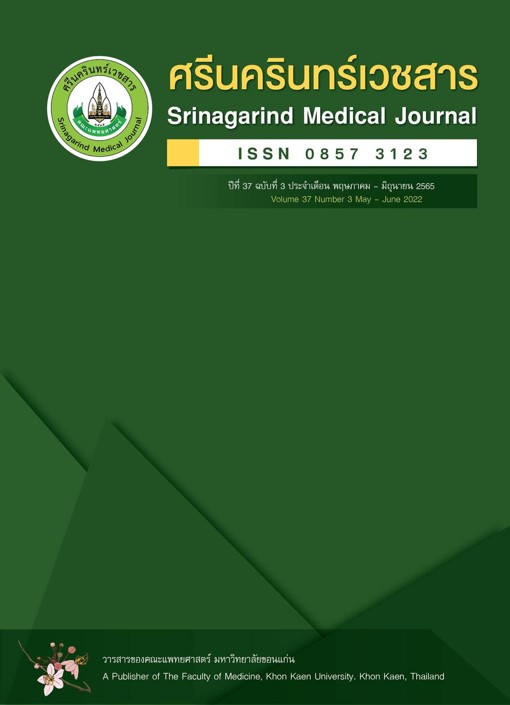Necrotizing fasciitis
Abstract
โรคแบคทีเรียกินเนื้อ
ภาณุ ธีรตกุลพิศาล
หน่วยศัลยศาสตร์อุบัติเหตุ ภาควิชาศัลยศาสตร์ คณะแพทยศาสตร์ มหาวิทยาลัยขอนแก่น
บทคัดย่อ
โรคแบคทีเรียกินเนื้อคือการอักเสบของเนื้อเยื่อใต้ผิวหนังที่มีการดำเนินโรครวดเร็ว รุนแรง มีการลุกลามต่อเนื่อง ซึ่งพบได้บ่อยในประเทศไทย ส่วนใหญ่พยาธิสภาพเกิดบริเวณรยางค์ คอ และลำตัว
โรคแบคทีเรียกินเนื้อมีสาเหตุการเกิดโรคหลัก 4 รูปแบบ คือ เกิดโรคหลังบาดแผล เกิดโรคหลังผ่าตัด ไม่ทราบสาเหตุ และเกิดจากภาวะแทรกซ้อนของการรักษาโรคติดเชื้อผิวหนัง โดยจะจำแนกประเภทตามแบคทีเรียวิทยาออกเป็น 3 กลุ่ม คือ กลุ่มที่หนึ่งเกิดจากการติดเชื้อจุลินทรีย์หลากหลายชนิด กลุ่มที่สองเกิดจากการติดเชื้อจุลินทรีย์ชนิดเดียว และกลุ่มที่สามเกิดจากการติดเชื้อจุลินทรีย์ที่ปะปนมากับน้ำทะเล
เมื่อแบคทีเรียเข้ามาฝังตัวในเนื้อเยื่อใต้ผิวหนัง จะมีการขยายตัวและการอักเสบตามมา ซึ่งจะเกิดการเน่าตายของเยื้อเยื่อ ส่งผลให้บริเวณที่เกิดพยาธิสภาพมีการอักเสบ อาการที่เห็นได้ชัดคือผู้ป่วยจะมีอาการปวดมากกว่ารอยโรคที่เห็นจากผิวหนัง ผิวหนังอาจมีการบวม แดง กดเจ็บ ร่วมกับมีไข้สูงได้ในระยะแรก ป่วยอาจมีการตอบสนองทางระบบร่วมกับมีอาการของภาวะช็อกจากการติดเชื้อ
หลักการรักษาภาวะแบคทีเรียกินเนื้อประกอบด้วย การให้ยาปฏิชีวนะและการให้สารน้ำที่เพียงพอ การผ่าตัดเนื้อตายและระบายหนอง การดูแลต่อเนื่องหลังผ่าตัด ตลอดจนการปิดแผลและฟื้นฟูสมรรถภาพ ซึ่งต้องอาศัยความชำนาญและความรวดเร็วในการรักษาของศัลยแพทย์จึงจะทำให้ผู้ป่วยมีผลการรักษาที่ดี
คำสำคัญ: แบคทีเรียกินเนื้อ, เนื้อเยื่ออักเสบ, ติดเชื้อผิวหนัง
Abstract
Necrotizing fasciitis is an infection of subcutaneous tissues and fascia, which have continuous aggressive and rapid progression of the disease. The disease is common in Thailand, and common in the extremities, neck, and body.
Necrotizing fasciitis causes four types of etiology which are post-traumatic, post-operative, idiopathic, and causes by the complication of cutaneous diseases. The bacteriology of disease has three types; polymicrobial, monomicrobial, and microbial from seawater.
When the pathogen enters subcutaneous tissue, they colonize and cause inflammation. The process results in the necrosis of tissues. The pathognomonic sign is the patient may experience pain out of proportion, local inflammation of the skin, high-grade fever, SIRS, sepsis, and septic shock.
Treatments of the disease include broad-spectrum antibiotics, aggressive resuscitation, adequate surgical debridement and drainage, post-operative care, wound closure, and rehabilitation, which requires the skill of surgeons.
Key words: necrotizing fasciitis, soft tissue infection, skin infection


